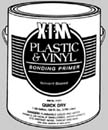Plastic
& Vinyl Bonding Primer White: Product Number 1143
Solvent Born, Bonding Primer Sealer, VOC: less than 450 g/l
• Properties of both a primer and an adhesive
•
Makes paint stick to plastics including PVC, Lexan, ABS, polypropylene
and TPO
•
Quick drying
•
Top coat with most all types of paint in hours
•
Tintable to pastels with universal tint colors.
Description:
XIM’s Plastic & Vinyl Bonding Primer is formulated to bond
strongly to a wide range of plastic & vinyl materials used in home
and building construction. When applied to a clean surface, it will
allow painting. Generally, plastic & vinyl materials and molded
parts could not be painted with long term confidence. When the XIM Plastic
& Vinyl Bonding Primer is used, regular oil-base alkyd paints, waterbased
latex paints, 2K urethanes and 2K epoxy paints can be used to paint
materials made of many plastics.
Product
Preparation: XIM’s Plastic & Vinyl Bonding Primer is ready
to use directly from the container. No thinning or reduction is required.
Mix well before application. It may require extra time on different
shakers to fully mix in any settled materials. Note: Keep the containers
tightly closed when not in use. Store at room temperature.
Clean-Up:
Clean equipment with mineral spirits, xylene or lacquer thinner immediately
after use. Do not allow the mixed finish to remain in the spray gun
or application equipment. Spray Gun Usage: When applying with spray
gun equipment, vapors can build up rapidly and may cause flash fire.
With all applications: vapors may travel to areas away from the work
site and ignite; use only where moving air will carry vapors outside.
Ground all equipment. Do not use where static electricity can build
up and cause sparks.
Clean-Up:
Clean equipment with XIM GON Cleaner, xylene, or lacquer thinner immediately
after use.
Surface
Preparation: Careful surface preparation and cleaning is the key to
a good result. Be sure the surface is thoroughly clean and dry, free
from all grease, wax, oil, polish, loose paint and dirt. Clean with
a strong abrasive detergent, rinse well and allow to dry. Rough surfaces
should be sanded smooth. Moldy or mildewed surfaces should be scrubbed
with a mixture of one quart of household bleach and three quarts of
water and then thoroughly rinsed with clean water. (Never mix bleach
with detergents - particularly detergents containing ammonia.) Solvent
wiping also recommended. Wipe down the surface with XIM GON Cleaner
or Xylene. Do not use mineral spirits, turpentine solvents that will
leave oily residues. Note: Some plastics are attacked by solvents -
always check a small area before proceeding.
How
to Apply: Use brush, roll or spray. The temperature of the surface and
the surrounding air should be between 50 deg. F and 100 deg. F. They
dry to touch in about 20-30 minutes under standard conditions (77 deg.
F and 50% relative humidity). Thicker coats will take longer to dry.
When using brush or roller, avoid excessive brushing or rolling because
the Bonder can tack the applicator to the recently applied Bonder. Work
in small areas and apply evenly. If an area is missed, wait a few minutes
until the bonder has dried before touching up. To slow down the drying
rate, small amounts of XIM’s XS Retarder or mineral spirits can
be added. It can be top-coated within 1 hour. See the table below for
top coat recommendations. Full cure is achieved in about 48 hours. For
conventional spray use Binks 62 gun, 66 fluid nozzle, 63 PB air nozzle,
or equivalent, at 40 to 60 psi atomization pressure. For airless spray
application use .015 to .019 orifice, 60 mesh strainer and 2000 psi
fluid pressure. For HVLP an internal pressure of 8 to 10 psi can be
used. It is best to apply the Bonding Primer in several light to medium
coats rather than one heavy coat. XIM Plastic & Vinyl Bonding Primer
will generally harden in 24 hours. If faster cure and hardening is desired
they can be force dried. NOTE: Recycled plastics, as well as plastic
additives such as mold release agents, flow additives, flame retardants,
etc. can affect primer adhesion. Because there are many types of plastics
and composite materials always test a sample for acceptable adhesion
before starting the job.
Plastics
Application Chart
Plastic
Materials
Recommended |
Common
Name |
Examples
of Trade Names |
| Acrylonitrile
Butadine Stryene |
ABS |
Various |
| Methyl
Methylacrylate |
Acrylic |
Plexiglas®,
Acrylite®, Lucite®, Crylex® |
| Cellulose
Acetate Buterate |
CAB |
Various |
| Fiberglass |
FPR |
Fiberglas® |
| Nylon |
--------- |
Various |
| Phenylene
Oxide |
--------- |
Noryl® |
Polycarbonate |
PC |
Hyzod®,
Tuffax CM-2, Lexan® MR-4000, Zelux®, Coex® |
| Polyester |
--------- |
Mylar®,
Haysite®, Homalite® |
| Polypropylene
|
PP |
Plasticore®,
Trovidur® |
| Polystryene |
PS |
Styrolux®,
Rexolite® |
| Polyurethane |
PU
|
Various |
| Polyvinyl
Chloride |
PVC |
Sintra®,
Trovicel® |
Thermoplastic Olefin |
TPO |
Always
test TPO for acceptable adhesion - May be polyethylene or a blend
Not Recommended |
| Fluorocarbon/Fluoropolymer
|
PFA,
PTFE |
Teflon®,
Kel-F, Halar®, Korton® |
| Polyvinylidine
Fluoride |
PVDF |
Kynar® |
| Polyvinylfluroide |
PVF |
Tedlar® |
| Polyethylene |
PE |
Low
or High Density Polyethylene |



